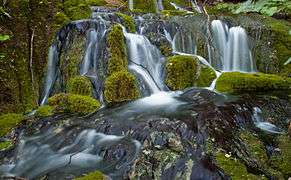Krka (Croatia)

Krka is a river in Croatia's Dalmatia region, noted for its numerous waterfalls. It is 73 km (45 mi) long and its basin covers an area of 2,088 km2 (806 sq mi).[1]
Possibly the river called Catarbates (literally "steeply falling")[2] by the ancient Greeks, it was known to the ancient Romans as Titius, Corcoras, or Korkoras.
The river has its source near the border of Croatia with Bosnia and Herzegovina, at the foot of the Dinara mountain. It flows past Knin in Inner Dalmatia towards the south and enters the Prokljansko jezero near Skradin.
The best known sites on the river path are the Visovac Monastery (Roman Catholic) and the Monastery Krka (Serbian Orthodox).
Before its outflow the river forms beautiful and well known waterfalls called Skradinski buk, part of Krka National Park. This area is also the location of the first hydroelectric power station using alternate current in Croatia, the Jaruga Hydroelectric Power Plant. This plant started supplying power to the nearby city of Šibenik in 1895.
See also
References
- ↑ "Geographical and meteorological data" (PDF). Statistical Yearbook. Croatian Bureau of Statistics. 2009. Retrieved 2011-07-10.
- ↑ Wilkes, J. The Illyrians. Blackwell, 1992. 101.
- Don Krsto Stošić, Rijeka Krka sa 54 slike, Tisak Pučke tiskare u Šibeniku, Šibenik Croatia 1927
Coordinates: 43°43′11″N 15°51′09″E / 43.7198°N 15.8526°E
| ||||||||||||||||||||
| ||||||||
|

